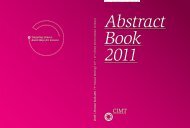Abstract Book 2010 - CIMT Annual Meeting
Abstract Book 2010 - CIMT Annual Meeting
Abstract Book 2010 - CIMT Annual Meeting
You also want an ePaper? Increase the reach of your titles
YUMPU automatically turns print PDFs into web optimized ePapers that Google loves.
058 Echchannaoui | Cellular therapy<br />
Evaluation of the safety of p53 TCR gene transfer in a<br />
humanized mouse model<br />
Hakim Echchannaoui 1 , Edite Antunes 1 , Carina Lotz 2 , Simone Thomas 1 , Ralf-Holger Voss 1<br />
and Matthias Theobald 1<br />
1 Department of Hematology & Oncology, University Medical Center, Mainz, Germany<br />
2 Actelion Pharmaceuticals Ltd, Allschwil, Switzerland<br />
102<br />
Adoptive cell therapy with T cells retrovirally trans-<br />
duced with tumor-associated antigen (TAA) specific<br />
TCRs is a promising approach for immunotherapy<br />
in patients with haematological malignancies. The<br />
TAA p53 is over-expressed in approximately 50% of<br />
human tumors. We have reported that HLA-A*0201<br />
(A2.1) transgenic mice can be used to circumvent<br />
self-tolerance to universal human TAA and to generate<br />
efficient tumor-reactive CTL. We used A2.1<br />
transgenic mice, in which the mouse CD8 molecule<br />
cannot efficiently interact with A2.1 to generate a<br />
high-affinity, CD8-independent p53(264-272) specific<br />
TCR. Retroviral expression of CD8-independent<br />
p53-specific TCR into T cells, allowed CD8+ T lymphocytes<br />
to acquire a broad tumor-specific CTL activity<br />
but also redirected CD4+ T cells into potent<br />
tumor-reactive, p53-specific T helper cells. However<br />
a particular safety concern with TCR gene transfer,<br />
is the formation of mixed TCR heterodimers<br />
between the introduced TCR α and β chains with<br />
the endogenous TCR chains, resulting in the potential<br />
generation of autoreactive T cells. To reduce<br />
the formation of TCR mixed dimers an additional<br />
inter-chain disulfide bond between the TCR α and β<br />
chain constant domains was introduced. We further<br />
improved the expression level of p53 TCR transgene<br />
using codon-optimization of the TCR sequence.<br />
Mouse T cells transduced with cysteine-modified<br />
(Cys) and codon-optimized (Opt) p53(264-272)A2.1<br />
TCR showed higher expression levels of the introduced<br />
TCR as compared to p53(264-272)-specific<br />
WT TCR. Importantly, p53(264-272)A2.1-Opt.Cys<br />
TCR transduced CTL recognized and killed a wide<br />
variety of malignant A2.1 tumor cells with altered<br />
p53 expression, but not p53-deficient A2.1 cells<br />
more efficiently as compared to CTL transduced<br />
with the WT p53(264-272)-specific TCR.<br />
However, when p53(264-272)A2.1-Opt.Cys TCR<br />
transduced mouse T cells are adoptively transferred<br />
into p53-deficient partially humanized (A2Kb)<br />
mice, under conditioning-induced lymphopenia,<br />
expansion of infused T cells following high dose<br />
IL-2 administration is associated with the development<br />
of lethal autoimmunity similarly to mice<br />
receiving p53(264-272)-specific WT TCR transduced<br />
T cells due to the formation of self-reactive<br />
TCRs. The so called off-target toxicity observed in<br />
our preclinical mouse model highlights the need<br />
for further improvement of TCR gene therapy to<br />
prevent TCR mispairing-induced autoimmunity. To<br />
address this concern, a novel single chain p53TCR<br />
construct was engineered and is currently under<br />
investigation.



